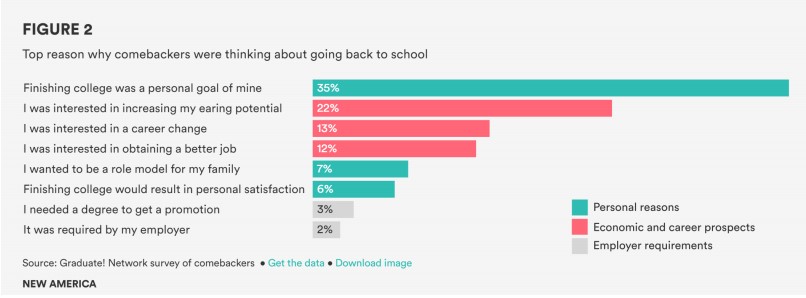In Florida, nearly 1.5 million working-age adults — that’s 13.5% of the state’s entire working-age population — have some college credit but no degree or short-term credential, according to the 2020 Lumina Foundation Stronger Nation report. These adults are missing out on the increased wages and job mobility that come with a degree. Because this group already has college credit and may be close to completing a degree, they represent a worthy investment in Florida’s talent-strong economy.
A new report by the Graduate! Network and New America looks at adults with college credit who intend to finish their degree, calling them “comebackers.” Using enrollment records from the National Student Clearinghouse for more than 7,800 comebackers, as well as interviews and surveys, the report explores why these students stopped college, why they may return, and what institutions and states can do to support their success. Ultimately, the report finds a majority of comebackers (68%) who returned to school stayed continuously enrolled until graduation, taking on average 1.6 years to complete their degree.
Comebackers may have stopped college for a variety of reasons — including self-doubt, a lack of guidance, financial and family issues — or a change in circumstance, such as pregnancy, illness, or the death of a parent. Now adults, these potential completers balance parenting, work, and paying for college. Of the students surveyed, most cited personal achievement as the primary driver to come back and complete their own degree. The second strongest motivator was maximizing their economic and career prospects.
What helps comebackers to the finish line? Guidance and employer incentives
The study finds those with guidance and advice are more likely to reenroll. Many students describe stopping school because they were in an unsustainable financial position and needed additional assistance. Others struggled with academic concerns, including issues with their major, scholastic difficulties, and unknown career prospects.
Since potential completers were last in school, websites, classes, and systems may have changed and many comebackers benefit from personalized help. The Graduate! Network found comebackers who had a handful of meetings with a Graduate! advisor were 2.4 times more likely to re-enroll. Guidance is essential for comebackers to finish after re-enrollment as well: comebackers report supportive school faculty and staff as the top factor that helped them graduate, even more so than family members, advisors, and mentors.
Another driver for comebackers’ success is access to employer education benefits. Both cost and work-education schedule conflicts are major roadblocks for adults wanting to return to school, but when employers support employee education, both groups benefit. These educational benefits impact employers as well; a 2016 Lumina Foundation report discovered employers with tuition reimbursement programs see a return on their investment. Beyond employees with new skills and degrees, employers who provide education benefits see increased worker retention, productivity, profits, and the development of in-house leadership skills. In addition to financial supports, other comebackers cited employer-given flexibility to take classes as an important source of support.
Recommended changes: Value the comebacker population and eliminate administrative barriers
When supporting comebackers to and through degree completion, it is critical to address bureaucratic barriers. For one in 10 comebackers who eventually went on to complete a degree, the barrier that caused their initial stop out was administrative, such as filing a graduation application or getting transfer credit recognized.
For other students, the barriers they face are more complicated. Some students struggled with punitive policies tied to institutional student debt, sometimes for non-tuition related fees like parking fines or library fees. Often, these fines balloon with interest and late fees, and keep students from completing or coming back to finish. Further, many schools withhold transcripts from and bar registration of students with institutional debt, blocking students from reenrollment and potentially trapping them in low-wage jobs. Instead, the report highlights model programs in the country that have worked to address these barriers, such as initiatives that forgive balances of up to several hundred dollars for students.
Figuring out how to better serve the “comebacker” population shows institutions how to better serve all students. Nearly half of today’s college students are 25 are older, almost 30 percent have children, and over 60 percent work at least part time. Additionally, according to the Graduate! Network, increasing the number of adults with degrees has a generational multiplier effect: when an adult earns a degree, the youth in their household are three times more likely to finish high school, go to college and earn a degree themselves.
Like many states, Florida recognizes the value of a degreed workforce, and holds a goal to increase the percentage of working-age Floridians with a high-value postsecondary certificate, degree, or training experience to 60% by 2030. The reengagement of adults with some college credit and no degree is an important strategy in reaching our attainment goal. The report recommends nonprofits, states, and colleges should create messages that speak to comebacker potential and use a growth mindset to urge comebackers to re-enroll in college. Fortunately, Florida can look to existing programs like Complete Tampa Bay, a new initiative from LEAP Tampa Bay — one of Florida’s 17 local college access networks — that provides free, personalized coaching and assistance for those with prior college or training experience, and help them complete their college degree and/or credentialing programs.
RELATED ARTICLES:
Getting to the Finish Line: Unique Postsecondary Barriers Adult Students Face
New statewide push to make Florida ‘Talent Strong’ promotes education after high school amid record unemployment


